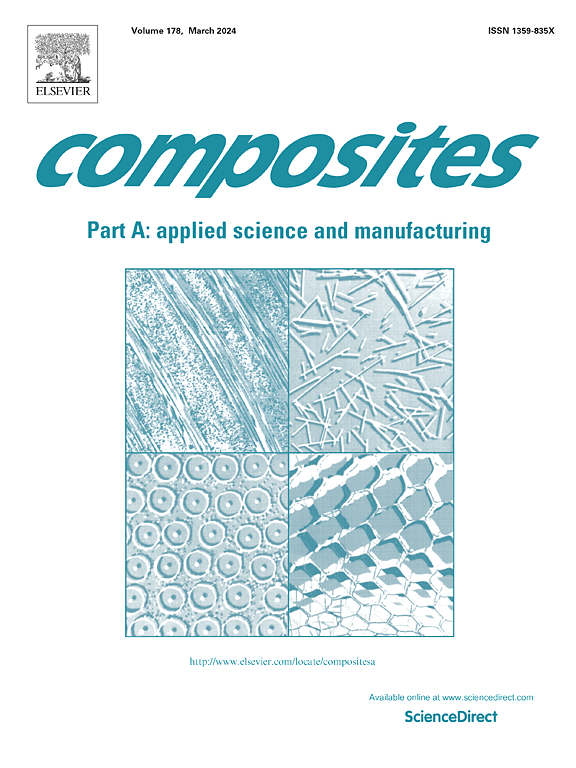3D打印销增强钛-复合材料复合接头界面疲劳性能
IF 8.1
2区 材料科学
Q1 ENGINEERING, MANUFACTURING
Composites Part A: Applied Science and Manufacturing
Pub Date : 2025-04-23
DOI:10.1016/j.compositesa.2025.108984
引用次数: 0
摘要
钛微销可以提高钛-复合材料接头的I型和II型层间断裂韧性。在这项研究中,我们测试了使用选择性激光熔化(SLM)制造的3D打印钛微针增强钛-复合材料接头的I和II型层间疲劳裂纹扩展能力。通过使用SLM在钛基板上打印一个正交排列的薄钛微针(直径1.0 mm)形成接头,然后将其嵌入到碳-环氧复合基板中,以创建微针增强的结合线界面。采用双悬臂梁(DCB)和端缺口挠曲(ENF)试验方法,在循环位移控制条件下进行了层间疲劳试验。在I型和II型循环加载下,由于微销在裂纹尖端后形成裂纹桥接区,钉接节点在等效裂纹扩展速率下的应变能释放率显著高于非钉接节点,增强了抗疲劳裂纹扩展能力。微销使I型和II型循环临界应变能释放率值分别提高了18倍和4倍。此外,还进行了单微针循环试验,以研究SLM Ti-pins在疲劳载荷下产生桥接牵引载荷的有效性。疲劳试验结果与断口学证据一起提出了疲劳强化和增韧机制。本文章由计算机程序翻译,如有差异,请以英文原文为准。
Interfacial fatigue performance of hybrid titanium to composite joints reinforced with 3D printed pins
Titanium micro-pins have been reported to enhance the modes I and II interlaminar fracture toughness of titanium-to-composite joints. In this study, we examined the enhancement of modes I and II interlaminar fatigue crack growth resistance of titanium-to-composite joints using 3D printed titanium micro-pins created using selective laser melting (SLM). The joints were formed by printing an orthogonal array of thin (1.0 mm diameter) titanium micro-pins over the titanium substrate using SLM, which were then embedded into a carbon-epoxy composite substrate to create a micro-pin reinforced bondline interface. Interlaminar fatigue experiments were conducted under cyclic displacement control conditions using the Double Cantilever Beam (DCB) and End Notch Flexure (ENF) test methods. Under modes I and II cyclic loading, pinned joints exhibited significantly higher strain energy release rates for equivalent crack growth rates due to the micro-pins forming a crack bridging zone behind the crack tip, enhancing fatigue crack growth resistance compared to unpinned joints. The micro-pins increased the modes I and II cyclic critical strain energy release rate value by 18-fold and 4-fold, respectively. A single micro-pin cyclic testing was also performed to investigate the efficacy of the SLM Ti-pins for generating bridging traction loads under fatigue loading. The fatigue test results are presented together with fractographic evidence of the fatigue strengthening and toughening mechanisms.
求助全文
通过发布文献求助,成功后即可免费获取论文全文。
去求助
来源期刊

Composites Part A: Applied Science and Manufacturing
工程技术-材料科学:复合
CiteScore
15.20
自引率
5.70%
发文量
492
审稿时长
30 days
期刊介绍:
Composites Part A: Applied Science and Manufacturing is a comprehensive journal that publishes original research papers, review articles, case studies, short communications, and letters covering various aspects of composite materials science and technology. This includes fibrous and particulate reinforcements in polymeric, metallic, and ceramic matrices, as well as 'natural' composites like wood and biological materials. The journal addresses topics such as properties, design, and manufacture of reinforcing fibers and particles, novel architectures and concepts, multifunctional composites, advancements in fabrication and processing, manufacturing science, process modeling, experimental mechanics, microstructural characterization, interfaces, prediction and measurement of mechanical, physical, and chemical behavior, and performance in service. Additionally, articles on economic and commercial aspects, design, and case studies are welcomed. All submissions undergo rigorous peer review to ensure they contribute significantly and innovatively, maintaining high standards for content and presentation. The editorial team aims to expedite the review process for prompt publication.
 求助内容:
求助内容: 应助结果提醒方式:
应助结果提醒方式:


